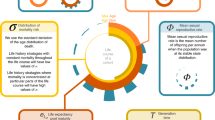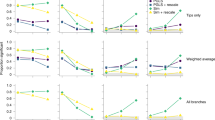Summary
A recent synthetic model of mammalian life history evolution predicts that αM = 3(1−δ0.25), where αM is the product of age at maturity and the average adult instantaneous mortality rate, and δ is the ratio of weight at independence to average adult female weight. Previous studies have tested this prediction by fitting a nonlinear regression to data collected for several species of mammals. However, this procedure suffers from non-independence of data points and may have led to incorrect estimates of regression parameters. We test the same life history prediction using phylogenetically independent contrasts with a phylogeny and data for 23 species of mammals. The results accord with the predicted relationship. Our study is one of the few examples where phylogenetic information has been used to improve the statistical power of a quantitative, model-based prediction of how life history variables should co-evolve.
Similar content being viewed by others
References
Bulmer, M., Wolfe, K. H. and Sharp, P. M. (1991) Synonymous nucleotide substitution rates in mammalian genes: implications for the molecular clock and the relationships of mammalian orders.Press Proc. Natl Acad. Sci. USA 88, 5974–8.
Calder, W. A. (1984)Size, Function and Life History. Harvard University Press, Cambridge, MA, USA.
Case, T. J. (1978) On the evolution and adaptive significance of postnatal growth rates in the terrestrial vertebrates.Q. Rev. Biol. 53, 243–82.
Charnov, E. L. (1991) Evolution of life history variation among female mammals.Proc. Nat. Acad. Sci. USA 88, 1134–7.
Charnov, E. L. and Berrigan, D. (1990) Dimensionless numbers and life history evolution: age of maturity versus the adult lifespan.Evol. Ecol. 4, 273–5.
Charnov, E. L. and Berrigan, D. (1991a) Dimensionless numbers and the assembly rules for life histories.Phil. Trans. Roy. Soc. Lond. (B) 332 41–8.
Charnov, E. L. and Berrigan, D. (1991b) Evolution of life history patterns in animals with indeterminate growth, particularly fish.Evol. Ecol. 5, 63–8.
Ellis, L. S. and Maxson, L. R. (1979) Evolution of the chipmunk generaEutamias andTamias.J. Mammal. 60, 331–4.
Felsenstein, J. (1985) Phylogenies and the comparative method.Amer. Natur. 125, 1–15.
Georgiadis, N. J., Kat, P. W. and Oketch, H. (1990) Allozyme divergence within the Bovidae.Evolution 44, 2135–49.
Grzimek, B. (1990)Encyclopedia of Mammals. 5 Vols. McGraw-Hill, New York, USA.
Hafner, D. J. (1984) Evolutionary relationships of the Nearctic Sciuridae. InThe biology of ground dwelling squirrels (J. O. Murie and G. R. Michener, ed.), pp. 3–23. University of Nebraska Press, Omaha.
Harvey, P. H. and Mace, G. M. (1982) Comparisons between taxa and adaptive trends: problems of methodology. InCurrent problems in sociobiology (King's College Sociobiology Group, ed.), pp. 343–61. Cambridge University Press, Cambridge, UK.
Harvey, P. H. and Nee, S. (1991) How to live like a mammal.Nature 350, 23–4.
Harvey, P. H. and Pagel, M. D. (1991)The Comparative Method in Evolutionary Biology. Oxford University Press, Oxford, UK.
Harvey, P. H. and Purvis, A. (1991). Comparative methods for explaining adaptations.Nature 351, 619–24.
Harvey, P. H. and Zammuto, R. M. (1985) Patterns of mortality and age at first reproduction in natural populations of mammals.Nature 315, 319–20.
Harvey, P. H., Read, A. F. and Promislow, D. E. L. (1989) Life history variation in placental mammals: unifying the data with theory.Oxford Sur. Evol. Biol. 6, 13–32.
Hight, M. E., Goodman, M. and Prychodko, W. (1974) Immunological studies of the Sciuridae.Syst. Zool. 23, 12–25.
Janis, C. M. (1988) New ideas in ungulate phylogeny and evolution.Trends Ecol. Evol. 3, 291–7.
Lavigne, D. M. J. (1982) Similarity of energy budgets of animal populations.Anim. Ecol. 51, 195–206.
Li, W.-H., Gouy, M., Sharp, P. M., O'hUigin, C. and Yang, Y. W. (1990) Molecular phylogeny of Rodentia, Lagomorpha, Primates, Artiodactyla, and Carnivora and molecular clocks.Proc. Natl. Acad. Sci. USA. 87, 6703–7.
Martins, E. and Garland, T. (1991) Phylogenetic analysis of the correlated evolution of continuous characters: a simulation study.Evolution 45, 534–57.
Nadler, C. F., Lyapunova, E. A., Hoffmann, R. S., Vorontsov, N. N., Shaitarova, L. L. and Borisov, Y. M. (1984) Chromosomal evolution in Holarctic ground squirrels (Spermophilus).Z. Säugetierkunde 49, 78–90.
Pagel, M. D. (1992) A method for the analysis of comparative data.J. Theor. Biol. 156, 431–42.
Pagel, M. D. and Harvey, P. H. (1989) Taxonomic differences in the scaling of brain on body weight among mammals.Science 244, 1589–93.
Partridge, L. and Harvey, P. H. (1988) The ecological context of life history evolution.Science 241, 1449–55.
Peters, R. H. (1983)The Ecological Implications of Body Size. Cambridge University Press, Cambridge, UK.
Promislow, D. E. L. and Harvey, P. H. (1990) Living fast and dying young: a comparative analysis of life history variation among mammals.J. Zool. 220, 417–37.
Read, A. F. and Harvey, P. H. (1989) Life history differences among the Eutherian radiations.J. Zool. 219, 329–53.
Reiss, M. J. (1989)The Allometry of Growth and Reproduction. Cambridge University Press, Cambridge, UK.
Reznick, D. (1985) Costs of reproduction: an evaluation of the empirical evidence.Oikos 44, 257–67.
Ridley, M. (1983)The Explanation of Organic Diversity: the Comparative Method and Adaptations for Mating. Oxford University Press, Oxford, UK.
Roff, D. A. (1984) The evolution of life history parameters in Teleosts.Can. J. Fish. Aqua. Sci. 41, 989–1000.
Sarich, V. M. (1985) Rodent macromolecular systematics. InEvolutionary relationships among Rodents; a multidisciplinary analysis (W. P. Luckett and J.-L. Hartenberger, eds), pp. 423–52. NATO ASI series A 92, Plenum Press, NY, USA.
Shine, R. and Charnov, E. L. (1992) Patterns of survivorship, growth and maturation in snakes and lizards.Amer. Nat. (in press).
Sprent, P. (1969)Models in Regression and Related Topics. Methuen, London, UK.
Stearns, S. C. (1983) The influence of size and phylogeny on life history patterns.Oikos 41, 173–87.
Wozencraft, W. C. (1986) Classification of the Recent Carnivora. InCarnivore Biology (J. L. Gittleman, ed.), pp. 569–93. Cornell University Press, Ithaca, NY, USA.
Author information
Authors and Affiliations
Rights and permissions
About this article
Cite this article
Berrigan, D., Charnov, E.L., Purvis, A. et al. Phylogenetic contrasts and the evolution of mammalian life histories. Evol Ecol 7, 270–278 (1993). https://doi.org/10.1007/BF01237744
Issue Date:
DOI: https://doi.org/10.1007/BF01237744




